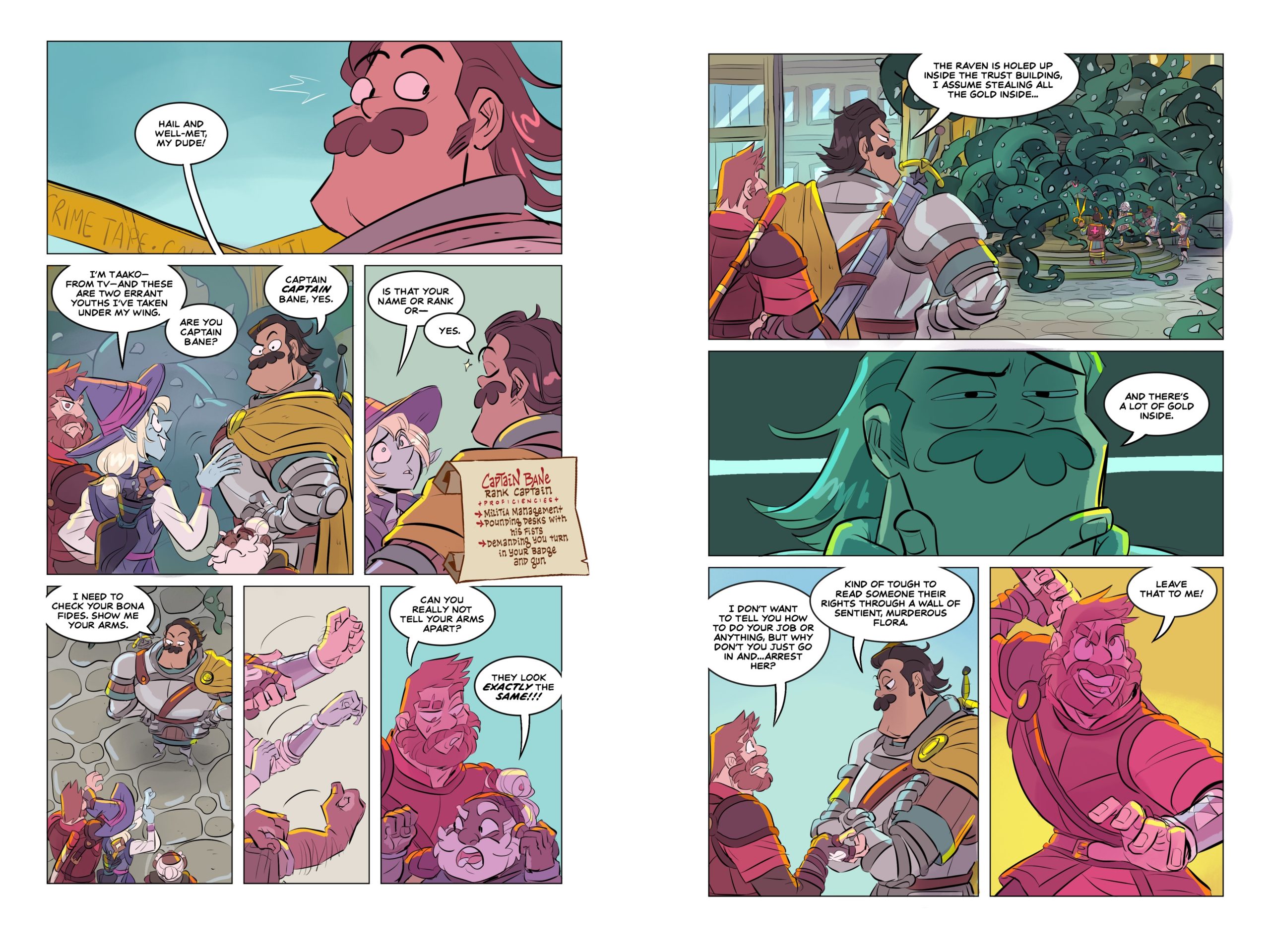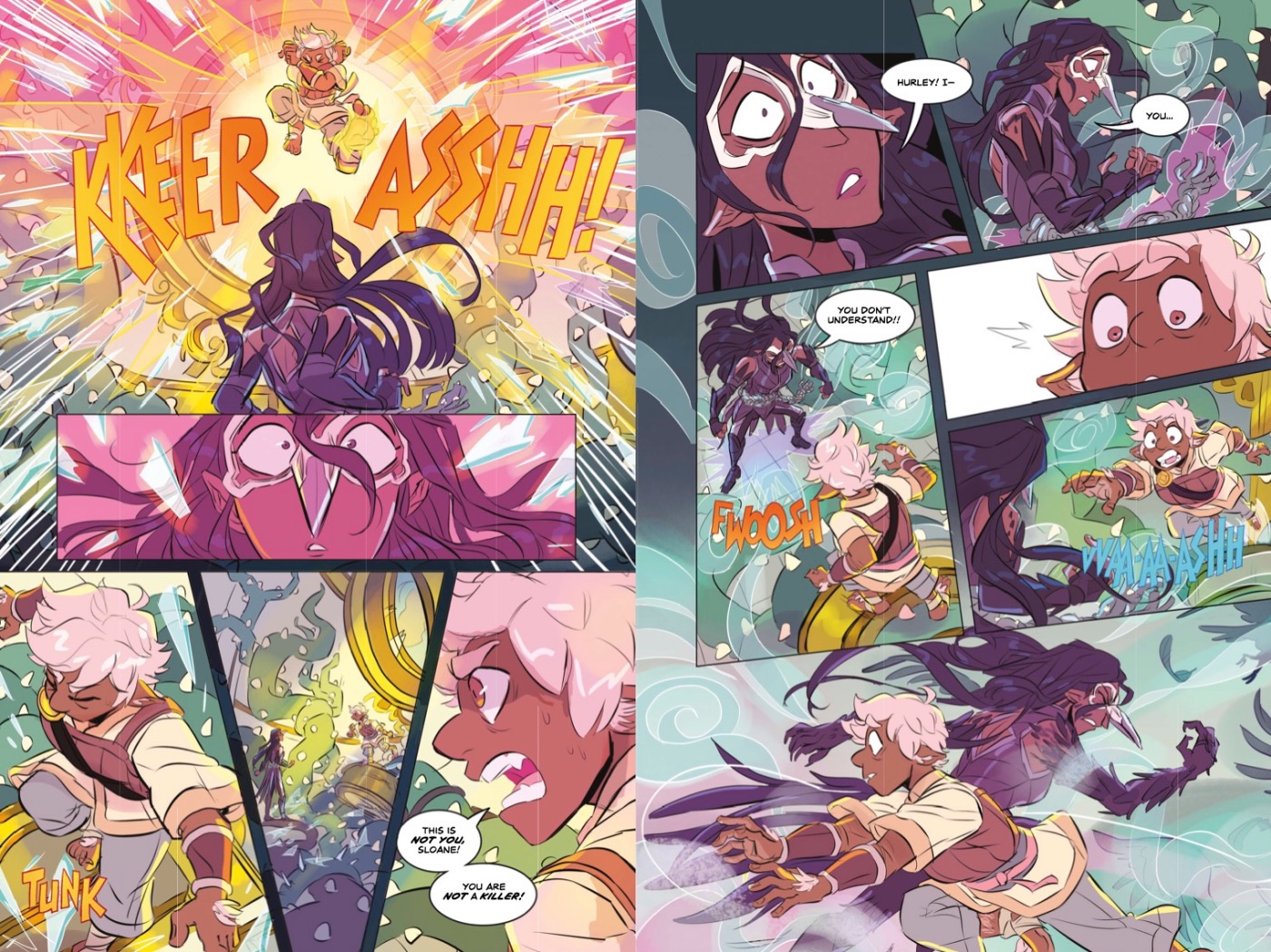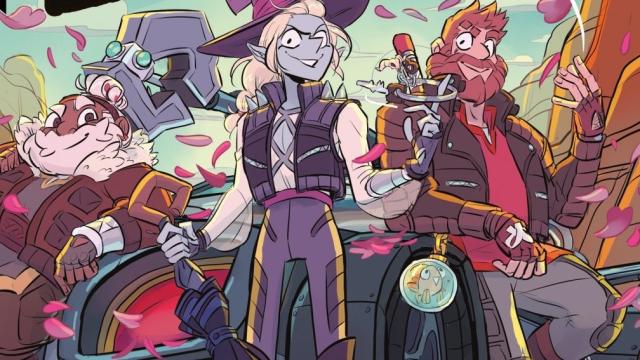Bury Your Gays“ trope. Speaking to Gizmodo, the creators of The Adventure Zone comic got honest about the challenges and opportunities of revisiting their most controversial storyline yet. And, of course, plant sex.
In an extensive interview over the phone, The Adventure Zone creators Griffin McElroy and Travis McElroy, along with The Adventure Zone comics artist and co-adaptor Carey Pietsch, talked about how they adapted the Sloane and Hurley romance storyline from “Petals to the Metal,” why no one wants to hear their daddy have plant sex, and whether we can expect more The Adventure Zone graphic novels in the future. We’ll have some interesting updates on The Adventure Zone Peacock animated series in the coming days.
Below is an edited, condensed version of the interview.

Gizmodo: It’s one thing to get a single comic, let alone a follow-up. But now you’ve had three in The Adventure Zone saga, which makes it a bona fide series. How does it feel to have reached this milestone?
Griffin McElroy: I mean, it felt pretty good when we got two out the door, that felt very series-like to me. But I guess two points makes a straight line, and not necessarily a series. It feels very bizarre. I think what feels bizarre is how used to it I feel. Not that I’ve become complacent, but that like, “Oh yeah, our book comes out next week.” And it’s like, “Oh yeah!” We’re very excited, but also, we’ve done it a few times before. It’s a very strange feeling to be sure.
Travis McElroy: For me, I think when we started it, we already had the story written and the fear of, like, writing the first book and everyone hating it and not getting to finish the series. That would be such a bummer. It would be such a bad look if we only got to put out one of potentially seven. That is such a clear, “Oh no.” And now we’re three in, and I would say that that has increased exponentially [laughs]. “We’re only getting six out of seven, oh no!”
Carey Pietsch: Yeah, I feel like Travis, I am terrified every time. But also, it’s really, really cool to be able to build from book to book ” not just in the way that we work together, but in the way that the characters interact on the page and the story kind of expands over time. So, “scared-cited”? Is that a thing? Both scared and excited?

Gizmodo: What were the unique challenges in adapting “Petals to the Medal” in particular?
Griffin McElroy: I mean, the hardest thing any of us had to do on this book is illustrate a wagon race. Carey can speak to that ” the challenges for us are like, “Oh no, we have to make this one joke be a different joke.” And it takes 15 seconds. And we’re like, OK, time to call it a day. For a hundred years, Carey had to draw cars over and over and over again.
Pietsch: I am not going to argue with the statement that the hardest drawing piece was the cars. I think that all of you four [brothers Justin, Travis, and Griffin McElroy, and their father Clint McElroy] have kind of talked about this book ” this chunk of the Balance Arc in particular ” as being kind of a turning point. I think that was a new adaptation challenge, certainly for all of you, kind of figuring out how how to emphasise the pieces of the larger story ” with the Red Robes and the Hunger that start coming into focus here, and how to bring those forward now that we know where those are going. But yeah, cars are difficult to draw, it turns out. Very hard.
Gizmodo: So what did you do, Carey, to make sure you were designing the cars to not only functionally work and serve the narrative, but also still make them fit in a fantasy world?
Pietsch: I made them as little like actual cars as possible, that was the number one goal. I think I spend a lot of time looking at movies that aren’t necessarily fantasy, but kind of exist in this heightened space. Think of Fast and the Furious, right? Those cars do things that a human driver and car combo could not possibly ” probably, as far as I know ” do. But more even than that, movies like and Redline, where the cars kind of become characters in and of themselves.
So, looking at a lot of those and figuring out how to kind of emphasise the visual language of exaggerated cartooning to kind of makes the cars ” battlewagons, sorry ” have that same feeling. I want you to be able to believe that this Cricket bobsled ” sorry, Velociraptor bobsled ” can speed in out of nowhere and go flipping through the air dramatically. Which requires making it look pretty cartoony and goofy, which luckily for me is also fun to draw.

Gizmodo: I guess this question is for whoever has the most “visceral” reaction first. There’s the Merle plant love scene, which is one of the most infamous and unsettling moments in the entire Balance Arc. What were your thoughts and feelings actually having to put it to paper?
Travis McElroy: [laughs] OK, here’s the thing. This is the trickiest thing about the way that we all work together. We kind of have to to operate on a bunch of different levels at the same time. On the one level, as three sons, I think we’re absolutely completely horrified to our very marrow. But on the other hand, as a co-creator I think it’s great! I think it’s funny and great, and it’s fun to see for that part of my brain. But for the majority of my brain, like 66% of my brain, absolutely horrified.
Griffin McElroy: It’s easy to distance from ” I’m not related to the character of Merle. Merle can fuck as many plants as you want. I don’t want to hear my human dad’s actual voice ” the same voice that said, “Great job son, I’m proud of you” when I won my Little League game in third grade ” also be the same voice that says “And then the plant tendrils, I don’t know, wrap around my balls” or whatever. That’s no good.
Travis McElroy: That line is not in the book, let’s be clear.
Griffin McElroy: That made it sound like we added more to that scene. We did not. I would argue it’s very tasteful.
Pietsch: Can we get that as a back cover blurb? “This is very, very tasteful plant sex, wonderfully drawn.”
Griffin McElroy: It’s not even sex, it’s making love. There’s a romantic thing there that has to be seen to be believed. [pauses] And now I’m uncomfortable.

Gizmodo: A big part of the “Petals to the Medal” storyline is the Sloane and Hurley story, one that you all have admitted stumbled into the Bury Your Gays trope (spoilers: Sloane and Hurley were a lesbian couple who died while saving each other from the story’s main threat, and in a much-later episode they were magically revived). What were the conversations you had about adapting this part specifically?
Griffin McElroy: There were actually so many conversations about it. It’s also kind of tough talking about this without spoiling the whole thing. But yeah, when we first visited this storyline in the podcast, Hurley and Sloane’s romantic relationship was the first time we’d attempted to convey any sort of romance in the show ” and, kind of by proxy, the first time I had tried to include romance in any kind of fictional narrative thing.
We were crazy about these characters, and I just completely walked into this trope of Bury Your Gays by giving them a sort of, like, heroic sacrifice ” not really knowing that that was a harmful thing throughout media, because I am a straight white dude who, you know, that is not really a thing for me. We learned from that what we were doing the podcast. And also, while we were still doing the podcast, we tried to address it in the narrative, which I’ll try not to get into. In the book, we kind of knew where that story was going to go, and what step we’d already taken to not step in shit quite as badly as we did. But even that, there were a lot, a lot, a lot of different conversations about how to fine-tune that, what to include.
This is all coming off as complete nonsense if you don’t know what happened in the podcast, and I apologise for that. But it was super, super, super important. I think the first draft we turned in did not go nearly hard enough in trying to fix the trope that we employed during the podcast, and it was a lot of conversations with Carey and [Alison Wilgus] our editor, and all of us to figure out the right solution for it. Out of that, I think we landed on an ending that we all feel great about, and truly beats the pants off of what happened in the podcast.
Pietsch: Also, I think all of us talked a lot about not just where the ending of this arc was planned, but also about how to flesh out their relationship earlier on ” in a way that I’m really, really, really proud of. I think they have a lot of room to breathe. Griffin has kind of talked about that being a consequence of the structure of an actual play podcast. Who the narrative can follow [in a tabletop RPG podcast] is very different from who the narrative arc can follow in a graphic novel. I really, really like what we ended up doing.
Gizmodo: Do you see the resolution of Sloane and Hurley’s story in the graphic novel as a changed ending from what you did before, or is it something else?
Griffin McElroy: If you listen to “Petals to the Metal” and stop listening there, this is of course a changed ending. If you listen to the entirety of the podcast, particularly what happens in the final [episodes], I do not think it is a changed ending. I don’t think it was us retroactively changing the ending of “Pedals to the Metal,” as much as it is changing the timing of events in Hurley and Sloane’s entire arc. That was sort of the key.
I mean, it is a change. It kind of has to be. It doesn’t come out of nowhere, it’s not made up out of whole cloth. It is, I feel, true to the podcast in a way that we all felt just made sense, and not just an easy way out.
Gizmodo: Are there plans to continue The Adventure Zone comic series?
Travis McElroy: Yes [laughs]. I’m not sure how much we’re allowed to say, but yeah, it would be wild if we were like, “Nope that’s it, thanks for reading everybody! What was that guy in the red robe all about, that was weird huh? Anyway, thanks for reading, you’ll never know!”
Pietsch: I think it says at the end of the book, “[The Adventure Zone: Crystal Kingdom] coming eventually.”
Griffin McElroy: It happens every book, and every book I feel like I’m the fucking kid who played Spider-Man just like, “Oh yeah!”
Pietsch: I need someone for a second to wave a wand and just call us.
Travis McElroy: I’m just gonna say it: Yeah! Next July. “Crystal Kingdom,” probably, we’re already working on it.
